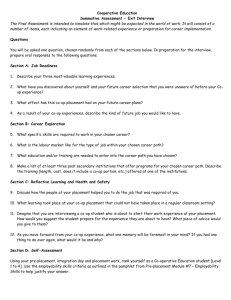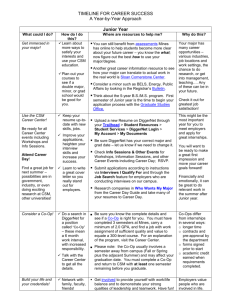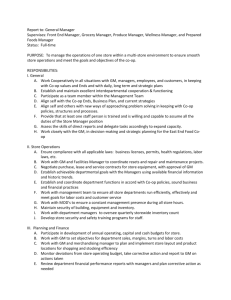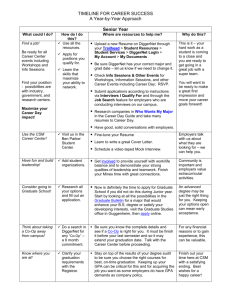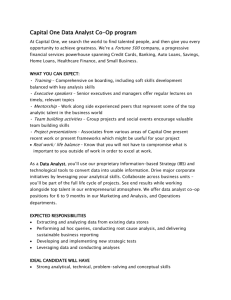Kelly Harper regarding the College's experiential
advertisement
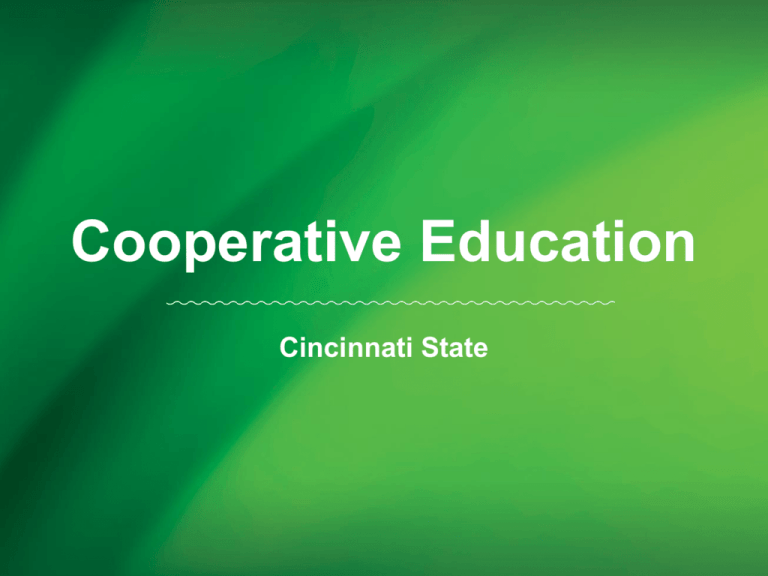
Cooperative Education Cincinnati State Cincinnati State was founded on the principle that education occurs best when classroom instruction is reinforced by related work experience acquired through Cooperative Education. Cincinnati State Accomplishments • First two-year college to establish mandatory co-op program in US. – First year, 118 students with 38 co-op employers. – Today, average 3,000 placements annually with approximately 700 employers. • 1998 E. Sam Sovilla Award of Excellence from CEIA • 2003-2011 ranked largest two-year co-op program in US and 4th largest including all universities in US. • 2007 inducted into the Cooperative Education Hall of Honor. Along with Georgia Tech, distinguished as the first college/university inductees. Who Benefits? Students Employers Cincinnati State Students • Enhances students’ marketability by providing valuable degree-related work experience to add to resume. • Enables students to earn money to help defray college expenses. • Develops professional competence and business skills. • Helps students gain exposure to the job market. • Make contacts in profession for future job searches. • Get job offers for permanent positions upon graduation. • Helps develop long range career goals and clarification of career goals. • Provides academic credit toward graduation. Work Integrated Learning at Cincinnati State In 2011-12, we awarded 1,510 Associate Degrees to 1,472 students Using the cohort of students above, within the past five years Number Percent Students participating in cooperative education: Students participating in clinical or practicum experiences: Students that completed an internship: 677 46.0% 393 102 26.7% 6.9% TOTAL 1172 79.6% 2011- 2012 Graduation Data Work Integrated Learning at Cincinnati State In 2011-12, we awarded 1,510 Associate Degrees to 1,472 students Using the cohort of students above, within the past five years Students with prior work experience in lieu of co-op: Students that had none of the above: Number Percent 211 258 14.3% 17.5% Total 469 20.5% 2011- 2012 Graduation Data Work Integrated Learning at Cincinnati State 1472 Degrees Awarded Students who participated in Work Integrated Learning 79.6% Students with Prior Work Experience in Academic Program 14.3% Students who participated in courses approved by college in lieu of co-op 17.5% 2011- 2012 Graduation Data Employers • Increases cost-effectiveness of recruitment and training. • Provides an opportunity to evaluate employees prior to a decision regarding full-time employment. • Allows flexibility in staffing needs. • Brings state-of-the-art technical knowledge to the workplace. • Fosters relationships with the academic community. Co-op Employers – Summer 2012 Placement and Wage Data – Spring 2012 DIVISION NUMBER PLACED MODE WAGES LOWEST WAGE HIGHEST WAGE AVERAGE WAGE ESTIMATED EARNINGS BUSINESS TECHNOLOGIES 257 15.00$ 3.85$ 26.92$ 10.72$ 741,500.01$ CENTER FOR 173 INNOVATIVE TECHNOLOGIES 7.70$ 7.25$ 29.00$ 11.12$ 544,702.91$ HEALTH AND PUBLIC SAFETY TECHNOLOGIES 019 15.43$ 10.00$ 17.89$ 14.00$ 42,916.10$ HUMANITIES 054 NONE 3.85$ 27.00$ 10.04$ 106,268.40$ SCIENCES 007 NONE 7.70$ 12.00$ 9.55$ 9,960.62$ TOTAL TOTAL WITH EARNINGS 495 NONE 510 3.85$ 29.00$ 11.09$ 1,445,348.04$ TOTAL INTERNSHIPS 015 INTERNSHIP INTERNSHIP INTERNSHIP INTERNSHIP INTERNSHIP Cincinnati State • • • • • • Provides recognition in the community. Serves as a recruitment tool for new students. Increases retention of current students. Fosters relationships with the business community. Keeps curricula relevant to the workplace. Helps to develop scholarship opportunities from local businesses. • Maintains our national exposure and reputation, thus attracting quality faculty, staff and administrators. How Does Co-op Work? How Co-op Works at Cincinnati State • Decentralized • Required for Graduation • Academic Credit Earned Co-op Process The Process • • • • • • • • • Student Recruitment/Orientation Job Development Employer Relations Interview Process Job Accepted Monitoring and Supervision On-Site Visits Reports and Evaluations Assignment Completion/Credit Granted Think Of Co-op As A Pathway Pre Requisite Courses Orientation Defining Co-op Path Completion of Co-op Requirement Who are our Co-op Coordinators? • Business Technologies – – – – – Yvonne Baker Kelly Harper Scott Holubetz Joe Roberts Adam Waits • Health and Public Safety – Janelle Gohn – Mickey Weber • Center for Innovative Technologies – – – – – Sue Dolan Andrea Feld Maya Franklin Noelle Grome Kim Richards • Humanities and Science – Jayne Dressing – Susan Munn What Positions Qualify? A position may qualify for co-op if: • The student will be paid for work performed. • The job relates to a curriculum or career choice of students. • The employer will supervise the student at work and evaluate the performance. • A faculty member may visit the student and supervisor on the job. • The possibility exists for student growth on the job, coinciding with advanced coursework. Types of Positions • Fulltime – typically 32-40 hours/week – Alternating semesters vs. Back-toBack • Part-time – 20-31 hours/week – Parallel – go to school and work Co-op Process Middletown Campus Co-op Expansion Process - Middletown • Single point of contact for students and employers – Including co-op orientations for student on Middletown Campus • Once student and employer are “qualified” we then work to transition them to the appropriate co-op coordinator in their academic program. • Coordinators working on this project include Yvonne Baker, Jayne Dressing, Noelle Grome, and Adam Waits. Co-op Enhancement Projects • AQIP Team • Ohio Means Co-op and Internship Grant – Focus on growth in Middletown area • Website • Marketing Materials



